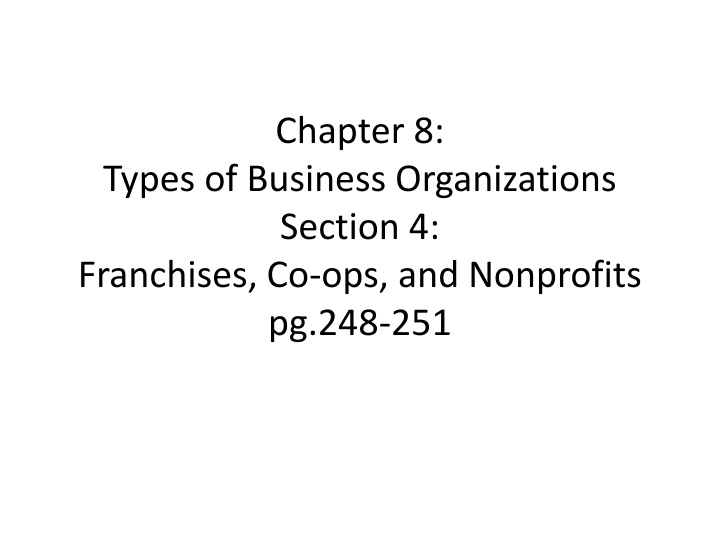
Franchises, Co-ops, and Nonprofits in Business Organizations
Explore the world of franchises, co-ops, and nonprofits in business organizations. Learn about the advantages and disadvantages of franchises, the concept of cooperatives, and how businesses operate for shared benefits. Uncover the diverse types of business structures that exist beyond traditional models.
Download Presentation

Please find below an Image/Link to download the presentation.
The content on the website is provided AS IS for your information and personal use only. It may not be sold, licensed, or shared on other websites without obtaining consent from the author. If you encounter any issues during the download, it is possible that the publisher has removed the file from their server.
You are allowed to download the files provided on this website for personal or commercial use, subject to the condition that they are used lawfully. All files are the property of their respective owners.
The content on the website is provided AS IS for your information and personal use only. It may not be sold, licensed, or shared on other websites without obtaining consent from the author.
E N D
Presentation Transcript
Chapter 8: Types of Business Organizations Section 4: Franchises, Co-ops, and Nonprofits pg.248-251
Franchises A franchise is a business made up of semi-independent businesses that all offer the same products of services. Each franchisee, as the individual businesses are known, pays a fee to the parent company in return for the right to sell the company s products or services in a particular area. Fast-food restaurants are the most common franchised business. However, this kind of business organization is also found in many other industries, including hotels, rental cars, and car service. https://franchisemeets.com/uploads/contents/indo_franchises.png
Worlds Leading Franchises https://pbs.twimg.com/profile_images/658746945565954048/Zrf2h3RD.jpg 1. McDonald s 2. Yum! (KFC, Taco Bell, etc.) 3. 7-Eleven 4. Cendent (Howard Johnson, Avis, etc.) 5. Subway 30,300 29,300 28,200 24,600 http://3f56jlmc7gxmzuo6df07v0t.wpengine.netdna-cdn.com/wp-content/uploads/wpallimport/files/assets/togo-logo/logo-avis-car-rental.jpg http://s3-media3.fl.yelpcdn.com/bphoto/7ltLJpz2m4NAT3DLTP8aeQ/o.jpg https://www.wesellrestaurants.com/public/uploads/images/46614-19028_tacoBellKFC_lg_lg.gif 21,000
Franchises: Advantages 1. As a franchisee, you have a level of independence that you would not have as an employee. The franchiser would provide good training in running the business. The franchiser would also provide proven products, and d cor common to all franchises. The franchiser would also provide national and/or regional advertising that would bring in customers. https://upload.wikimedia.org/wikipedia/commons/thumb/e/e5/Subway_restaurant.svg/2000px-Subway_restaurant.svg.png 2. 3. 4.
Franchises: Disadvantages http://www.sgs-law.com/wp-content/uploads/2015/12/7-eleven-brand.svg_.png 1. You would have to invest much money into the franchise, with no assurance of success. You would have to share some of the profits with the franchiser. You would not have control over some aspects of the business. For example, you would have to meet the franchiser s operating rules, such as buying materials only from the franchiser and limiting the products offered by the franchiser. 2. 3.
Cooperatives or Co-ops http://missoulafoodcoop.com/wp-content/uploads/2013/11/cooperatives.png A cooperative is a type of business operated for the shared benefit of the owners, who are also its customers. When people who need the same goods or services band together and act as a business, they can offer low prices by reducing or eliminating profit. This is a co-op. There are three types of co-ops.
Consumer Co-ops http://i.huffpost.com/gen/1798406/original.jpg Consumer, or purchasing, co-ops can be small organizations, like an organic food cooperative, or they can be giant warehouse clubs. Consumer Co-ops require some kind of membership payment, either in the form of labor or monetary fees. They keep prices low by purchasing goods in large volumes at a discount price.
Service Co-ops https://www.educationcu.com/images/logo.jpg Service Co-ops are business organizations, such as credit unions, that offer their members a service. Employers often form service cooperatives to reduce the cost of buying health insurance for their employees.
Producer Co-ops http://www.eastsidefood.coop/sites/default/files/Marketing/OrganicValleyCoop4.jpeg Producer Co-ops are mainly owned and operated by the producers of agricultural products. They join together to ensure cheaper, more efficient processing or better marketing of their products.
Nonprofit Organizations http://www.wesleyrhowellcpa.com/wp-content/uploads/2015/07/Non-Profit-Organization-Services-1.png A nonprofit organization is an institution that acts like a business organization, but its purpose is usually to benefit society, not to make a profit. There are several different types of nonprofits.
Nonprofit Organizations https://community.wwe.com/sites/default/files/styles/hero_format/public/20110504_wwe_redcross_japan.jpg?itok=IDbgbLfE Some, like the American Red Cross, have the purpose of benefiting society. They provide their goods or services for free or for a minimal fee.
Nonprofit Organizations Other nonprofits, like the American Bar Association, are professional organizations. Such organizations exist to promote the common interests of their members. Business associations, trade associations, labor unions, and museums are all examples of organizations pursuing goals other than profits. Nonprofits are set-up like corporations. They have to receive a government charter, but most don t have to pay taxes. They receive most of their money from donations, grants, and membership fees. https://upload.wikimedia.org/wikipedia/commons/thumb/3/3f/American_Bar_Association.svg/2000px-American_Bar_Association.svg.png











